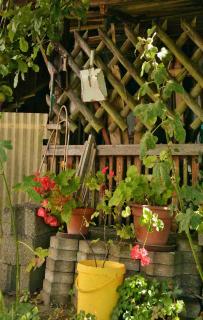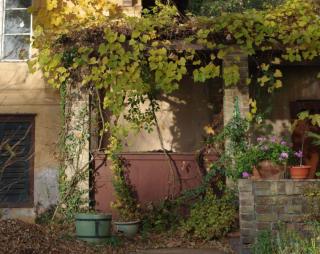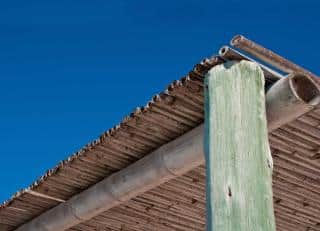

Guest post resulting from our collaboration with FRANCE ABRIS! Proud of your beautiful garden shed? Think how amazing it would look with a few beautiful vines crawling and blooming here and there! Indeed, though our garden sheds and pergolas are more and more beautiful on their own, it truly makes a difference when plants bring on a homely touch, making it fit right in the garden. What can be cuter than a nice wooden shed partly hidden from view by a bubbling honeysuckle vine? Or an elegant pergola dressed with a pair of clematis?
Well, there you have it: the best way to succeed in integrating shed and garden is to have a climbing vine run along it. Vines, whether they strive up tall posts or creep along the wall of the garden shed you’ve chosen, will either highlight and draw attention to the area or, oppositely, conceal it from view.
Which plants are best to grow near a garden shed or terrace extension? It depends: 1/ where you live; 2/ what style you’re pursuing; 3/ which structure you’re covering.
Of course, you won’t choose the same type of vine to cover a shed, hide a post, or crawl atop a pergola.
Similarly, you must consider exposure when choosing your plant decor, and check that it matches your climate: temperatures, air moisture, freezing… Ivy, wisteria, rose trees and honeysuckle are clearly among the most resistant species. Climbing hydrangea needs shade, so it’ll do great due north (or south if in the Southern hemisphere).
Its counterpart for sunny south-facing facades (north in the southern hemisphere) are bougainvillea and passion vine, both of which will die off if they don’t get enough sun.
Lastly, consider the building material: from an ornamental point of view, some plants pair better with wood panels than they do with aluminum and vice-versa.
There are dozens of possibilities, but there are clear differences among them. Let’s say you wish to hide the walls of your galvanized iron garden shed… You’ll probably opt for a climbing vine that has dense, evergreen leafage, like honeysuckle or an evergreen clematis. These will grant you with a bonus – abundant blooming – when the right season rolls around. Another option if you live in milder climates is a Banks rose.
 On the other hand, if your initial goal is to be decorative in itself, sheathing an appealing arbor with plants, for instance, you might drift towards species with renowned blooming qualities and fragrance instead. Spanish or medicinal jasmine, fragrant wattakaka, wisteria (though its blooming is somewhat unpredictable), trumpet vine with its fabulous trumpet-like flowers… Radically different options, all very ornamental!
On the other hand, if your initial goal is to be decorative in itself, sheathing an appealing arbor with plants, for instance, you might drift towards species with renowned blooming qualities and fragrance instead. Spanish or medicinal jasmine, fragrant wattakaka, wisteria (though its blooming is somewhat unpredictable), trumpet vine with its fabulous trumpet-like flowers… Radically different options, all very ornamental!
Last to consider is the lattice or trellis itself:
 none for those vines that have their own way of latching on to surfaces, even smooth ones like pergola posts: virginia creeper, climbing hydrangea and trumpet vine are in this category.
none for those vines that have their own way of latching on to surfaces, even smooth ones like pergola posts: virginia creeper, climbing hydrangea and trumpet vine are in this category.Inevitably, you’ll have to adjust each type of structure with the garden shed you’re covering with plants. Posts that are part of an arbor will carry self-latching plants easily, whereas wooden or PVC garden sheds may require a full trellis.
Another thought: what if you replaced climbing plants with a veil of bamboo stems instead? Potted bamboo grows very well, and is particularly effective at blocking the view of undesirable buildings.
 Another way is to use cut bamboo mats and fasten them to the roof of your garden shed. They’ll protect the underlying material against ultraviolet rays and avoid breakage during hailstorms. So bamboo solutions are also great options to close out a side of your open pergola. When compared to expensive exotic wood, bamboo fares just as well against rot and insects, and only comes around at a fraction of the cost. These stems are very elegant and ornamental, and rightfully boast an organic, natural look. Go ahead! But remember that for planted bamboo, there’s always the risk of turning invasive!
Another way is to use cut bamboo mats and fasten them to the roof of your garden shed. They’ll protect the underlying material against ultraviolet rays and avoid breakage during hailstorms. So bamboo solutions are also great options to close out a side of your open pergola. When compared to expensive exotic wood, bamboo fares just as well against rot and insects, and only comes around at a fraction of the cost. These stems are very elegant and ornamental, and rightfully boast an organic, natural look. Go ahead! But remember that for planted bamboo, there’s always the risk of turning invasive!
The choice is yours, you’ve seen that many options are available.